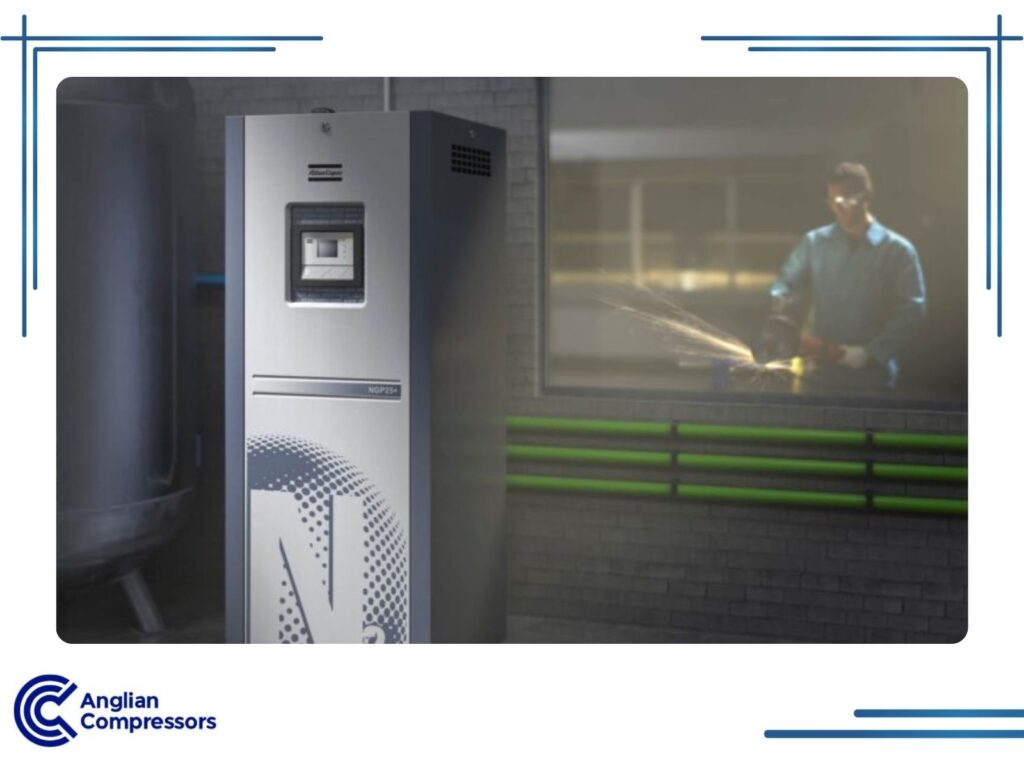What is membrane nitrogen generation?
Nitrogen plays a pivotal role in various industrial sectors, thanks to its inert properties.
In food and beverage packaging, it extends shelf life by displacing oxygen, preventing spoilage, and preserving freshness. Pharmaceutical manufacturers use nitrogen to ensure the stability and purity of their products by creating an inert atmosphere that prevents oxidation and contamination. In chemical processing, nitrogen is used for blanketing and purging, safeguarding sensitive reactions and maintaining the integrity of the process.
These industries need a 95% mix (or better) of pure nitrogen for commercial purposes.
Traditionally, industries relied on deliveries of nitrogen gas in cylinders or bulk tanks, which can be cumbersome, expensive, and prone to supply disruptions. However, a paradigm shift is occurring with the emergence of on-site nitrogen generation using membrane technology.
This innovative approach allows businesses to produce their own nitrogen supply directly at their facility, eliminating the need for external deliveries and offering greater control over their nitrogen production.
Table of Contents
What is Membrane Nitrogen Generation?
Membrane nitrogen generators rely on clean compressed air, which passes through a membrane containing numerous hollow fibres. These permeable fibres permit water vapour, oxygen, and miscellaneous fast gases to escape. Meanwhile, the membrane fills up with slow gases, primarily nitrogen.
The control methods for nitrogen generation are the pressure level and flow rate of compressed air moving through the membrane. Nitrogen purity levels vary but sit between a 95-99% range, which is sufficient for scientific labs, and various industrial and commercial settings where N2 is used.
Nitrogen membrane generators do not generate waste gas. Operating them only when additional N2 is required is possible because of their minimal start-up time. Also, the lack of mechanical moving parts helps to avoid breakdowns, too.
How Does Membrane Technology Work?
With a nitrogen membrane generator, small membrane modules store polymer fibres inside. These are numerous and hollow, to allow both air flow and permeation to occur.
Permeation: What is it?
Permeation is a process whereby compressed air enters, first inside the membrane modules, and later the polymer fibres themselves. As previously cleaned, high-pressure compressed air moves through the fibres, it helps to separate distinct elements.
Gas separation, oxygen molecules, H2O, carbon dioxide, water vapour, air impurities, and oil in a vapourised form permeate the membrane fibres. This permeation process occurs at a different rate, depending on what the element is.
H2O is removed very quickly, whereas oxygen lags a little. Argon – which is present at a roughly 1% rate in Earth’s atmosphere – will partially permeate when given time to do so. However, some Argon will still be present with the remaining nitrogen.
It’s All About the Membranes
The membranes have a concentration gradient surface on either side. This allows for distinct elements to permeate the sides while nitrogen flows through the hollow fibres unimpeded.
When it comes to N2 purity, the size of the individual pores within the membranes is a significant factor. Therefore, the membranes are specific to the purpose and the purity levels required.
The Need for Venting
No waste gas is expelled during the N2 membrane-based production process. Venting so-called “fast exhaust gasses” is necessary, though, including Argon, H2O, and oxygen. Without doing so, the polymer fibres eventually become clogged, and permeation efficiency suffers. Then purity levels decline sharply too.
Membrane-based generators include a permeate vent to address this issue.
Benefits of Using a Membrane Nitrogen Generator
Membrane nitrogen generation is a superior solution for many industries. By producing nitrogen on-site, businesses gain control, cut costs, and reduce their environmental impact. But what are the specific advantages that make this technology so appealing? Let’s dive in and explore the key benefits.
Cost Efficiency
Membrane nitrogen generation offers a compelling advantage in terms of cost efficiency. Unlike traditional methods like cryogenic distillation, which require significant energy input to separate nitrogen from the air, membrane technology operates at lower pressures and temperatures. This translates to a substantial reduction in energy consumption and, consequently, lower operational costs.
Additionally, eliminating the need for frequent deliveries of nitrogen cylinders or bulk tanks further contributes to cost savings. Even storing nitrogen cylinders costs real estate and space.
For businesses that rely on a consistent and reliable supply of nitrogen, the cost-effectiveness of membrane generators can lead to a rapid return on investment. By reducing energy bills and eliminating delivery charges, membrane nitrogen generation becomes an attractive option for long-term cost optimization.
Purity and Control
One of the most significant advantages of membrane nitrogen generation is the ability to tailor nitrogen purity to specific industrial requirements. Membrane systems can produce nitrogen with purities ranging from 95% to 99.5%. This flexibility allows businesses to fine-tune their nitrogen output to match the exact purity needed for their processes, avoiding unnecessary overproduction of high-purity nitrogen, which is wasteful and costly.
This precise control over nitrogen purity not only ensures optimal performance in various applications but also contributes to cost efficiency. By generating nitrogen at the required purity level, businesses can avoid paying for higher-purity nitrogen than they need, further maximising the economic benefits of membrane technology.
Simplicity and Reliability
Membrane nitrogen generators are renowned for their simplicity and reliability. Unlike complex cryogenic distillation systems, membrane generators have a straightforward design with fewer moving parts, making them less prone to breakdowns and requiring minimal maintenance. This translates to greater uptime and reduced maintenance costs.
The ease of installation is another advantage of membrane technology. These systems are compact and modular, requiring minimal floor space and infrastructure. Their straightforward operation means that personnel with minimal training can effectively manage the nitrogen generation process. This combination of simplicity and reliability makes membrane nitrogen generation a dependable choice for businesses seeking a continuous and hassle-free nitrogen supply.
Environmental Advantages
Membrane nitrogen generation is not only economically sound but also environmentally friendly. Unlike traditional methods, which often involve energy-intensive processes and transportation of nitrogen in heavy cylinders or tanks, membrane technology has a smaller carbon footprint. By generating nitrogen on-site, businesses can reduce their reliance on transportation, minimising emissions associated with deliveries.
Furthermore, the lower energy requirements of membrane generators contribute to a more sustainable approach to nitrogen production. By choosing membrane technology, businesses can be environmentally responsible and friendly all at a cheaper operational cost.

How Membrane Technologies Compare to Pressure Swing Adsorption PSA
Nitrogen generators for most applications are superior to pressure swing adsorption methodologies.
The generators themselves are compact, but also lighter too. For busy labs or other locations, membrane nitrogen systems are far quieter. This avoids the need to wear protective earplugs, which in some settings is inconvenient or makes real-time communication problematic.
N2 purity is a critical factor too. Membrane-based generators achieve a 99.9% efficiency rating under perfect conditions. The PSA systems potentially achieve as high as 99.999%, yet rarely is this required in real-world environments.
When nitrogen supply flow rates and pressure levels must remain consistent, then PSA isn’t ideal. Rates and levels may fluctuate and be harder to control with these systems. Nitrogen membrane systems include digital controllers offering precise control. With Atlas Copco’s NGM membrane-based system, external cylinders aren’t required to achieve consistent flow and pressure levels. This results in reliable, efficient production levels rather than uncertain, inefficient ones.
Lastly, membrane technologies do not result in waste gas generation. Unfortunately, PSA produces waste gas during a blow-off phase that must be safely managed. Environmental regulations and the risk of sizable fines remind businesses of the need to do so.
Membrane nitrogen generation
Let Anglian Compressors Help Guide You
Choosing the right nitrogen generation technologies for your business isn’t easy. While there are key benefits to adopting a membrane generator over a PSA system, we can advise correctly for your specific needs.
This way, you’ll receive a best-in-class nitrogen generation system with excellent energy efficiency, using the smallest possible footprint.
Contact us below.


